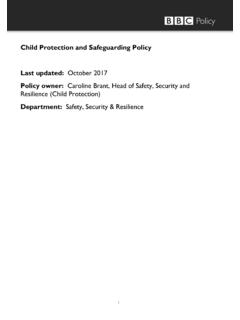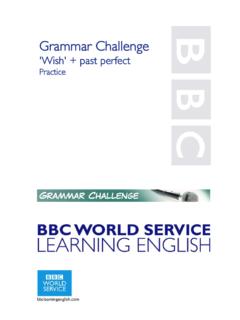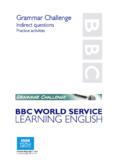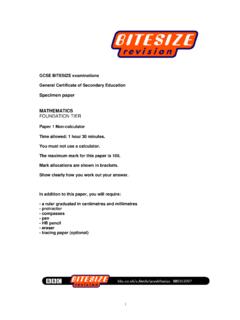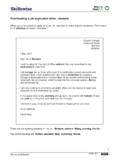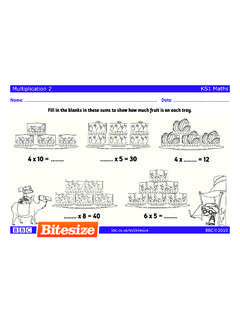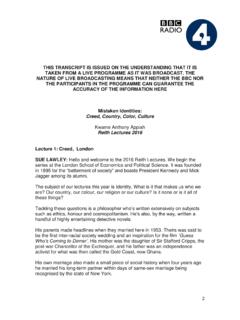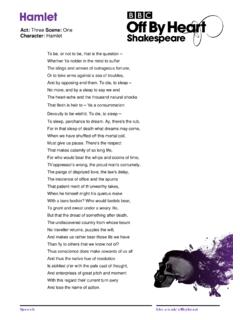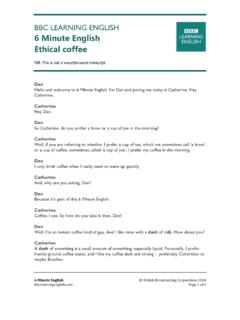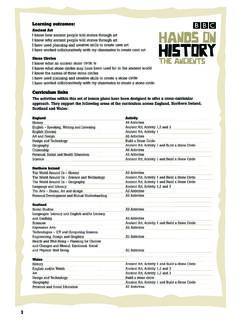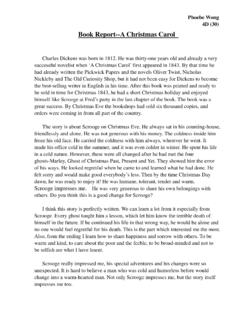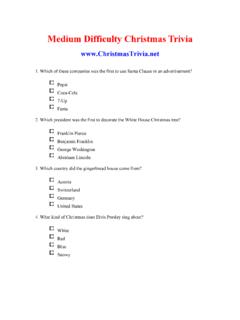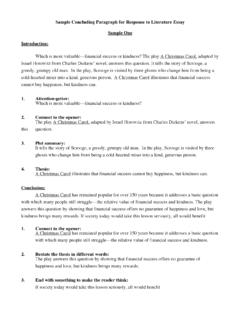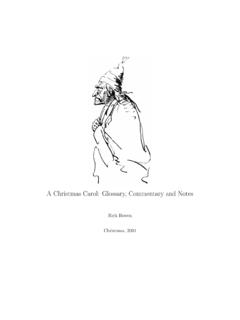Transcription of A Christmas Carol - BBC
1 A Christmas CarolSchool Radio BBC RadioI have endeavoured in this Ghostly little book to raise the Ghost of an Idea which shall not put my readers out of humour with themselves, with each other, with the season or with me. May it haunt their houses pleasantly, and no-one wish to lay faithful Friend and 1843 How to listen or watch:A Christmas Carol has been abridged in 9 episodes, each approximately 15 minutes episode displays the text on screen while you listen. If you would prefer to use the audio only you can download the episodes the website you will also find transcripts of each episode which can be printed out, copied and distributed as you :Reader: Alan SmithOriginal music: Martin Medina Teacher s Notes: Caroline Garland For the BBC: Andrew BarnesContents:Introduction 2 Primary Literacy Framework links2 Explanation of drama techniques5 NB - programme titles are hyperlinked to the rel-evant website pages:Episode 1: Marley s ghost 6 Episode 2: Meeting with Marley8 Episode 3: The first of the three spirits10 Episode 4: Master Fezziwig11 Episode 5: The second of the three spirits 13 Episode 6: Scrooge s nephew14 Episode 7.
2 The last of the three spirits16 Episode 8: An end to the haunting17 Episode 9: The end of it19 Cross-curricular links:20 School Radio BBC RadioIntroduction:Charles Dickens was born in Portsmouth on 7 February 1812, to John and Elizabeth Dickens. His schooling from the age of nine was limited due to his father being imprisoned for bad debt. Separated from his family, the young Dickens was sent to work in a blacking factory where he worked in appalling conditions. This must have been a traumatic experience for a young boy and Dickens would have endured great loneli-ness, pain and hardship. He eventually returned to school after three years of labour and his experiences became particularly immortalised in his novels David Copperfield and Great eventually succeeded in becoming a journalist, writing for The Mirror of Parliament and The True Sun and then for The Morning Chronicle where he started in 1833.
3 It was at this time he published his sketches under the pseudonym of Boz .In 1836 Dickens married Catherine Hogarth and they went on to have ten children. In the same year of his marriage Pickwick Papers was published. His work was often serialised in the newspaper at this time and would have been the soap opera of the day. Dickens wrote A Christ-mas Carol in 1843 in order to promote good will and charity at Christmas died of a stroke in 1870. He is buried at Westminster real A Christmas Carol of the time:A Christmas Carol was immensely popular in 1843. Eight stage productions had been put in to production within two months of the book s publication. It continues to be as popular today over 150 years later. Dickens himself was involved with many chari-ties and social issues throughout his life.
4 At the time he wrote A Christmas Carol he was very concerned with the plight of impoverished children who often turned to crime in order to saw education as a way in which children could eventually lead a better life and The Ragged School movement of the time put this thinking in also the Victorians Audio Clips library by copy-ing and pasting the following link into your Focus for Reading Levels 4 and 5, selected for relevance to the text:AF2 understand, describe, select or retrieve information, events or ideas from texts and use quotation and reference to textLevel 4 some relevant points identified comments supported by some generally rele-vant textual reference or quotation, refer-ence is made to appropriate section of text but is unselective and lacks focusLevel 5 most relevant points clearly identified, including those selected from different places in the text comments generally supported by relevant textual reference quotation, even when points made are not always accurateAF3 deduce, infer or interpret information, events or ideas from textsLevel 4 comments make inferences based on evidence from different points in the text.
5 Interpret-ing a character s motive from their actions at different points inferences often correct, but comments are not always rooted securely in the text or repeat narrative or contentLevel 5 comments develop explanation of inferred meanings drawing on evidence across the text, you know her dad was lying because ear-lier she saw him take the letter 2 School Radio BBC RadioSchool Radio BBC Radio comments make inferences and deductions based on textual evidence, in drawing conclusions about a character s feelings on the basis of their speech and actionsAF4 identify and comment on the structure and organisation of texts, including gram-matical and presentational features at text levelLevel 4 some structural choices identified with simple comment, he describes the accident first and then goes back to tell you why the child was in the road Level 5 comments on structural choices show some general awareness of author s craft, it tells you all things burglars can do to your house and then the last section explains how the alarm protects you AF5 explain and comment on writers use of language, including grammatical and liter-ary features at word and sentence levelLevel 4 some basic features of writer s use of lan-guage identified, all the questions make you want to find out what happens next simple comments on writer s choices, disgraceful is a good word to use to show he is upset Level 5 various features of writer s use of language identified, with some explanation.
6 When it gets to the climax they speak in short sen-tences and quickly which makes it more tense comments show some awareness of the effect of writer s language choices, inked up is a good way of describing how the blackberries go a bluey black colour as they ripen AF6 identify and comment on writers pur-poses and viewpoints, and the overall effect of the text on the readerLevel 4 main purpose identified, it s all about why going to the dentist is important and how you should look after your teeth simple comments show some awareness of writer s viewpoint, he only tells you good things about the farm and makes the shop sound boring simple comment on overall effect on reader, the way she describes him as ratlike and shifty makes you think he s disgusting Level 5 main purpose clearly identified, often through general overview, the writer is strongly against war and wants to persuade the reader to agree viewpoint in texts clearly identified, with some, often limited, explanation, at the end he knows he s done wrong and makes the snake sound attractive and mysterious general awareness of effect on the reader, with some, often limited, explanation, you d be persuaded to sign up because 25p a week doesn t seem that much to help someone see AF7 relate texts to their social, cultural and historical traditionsLevel 4 features common to different texts or versions of the same text identified, with simple com-ment, characters, settings.
7 Presentational features simple comment on the effect that the read-er s or writer s context has on the meaning of texts, historical context, place, social relationshipsLevel 5 comments identify similarities and differences between texts, or versions, with some expla-nation, narrative conventions in tradi-tional tales or stories from different cultures, ballads, newspaper reports some explanation of how the contexts in which texts are written and read contribute to mean-ing, how historical context influenced adverts or war reports from different times/places; or how a novel relates to when/where it was written3 School Radio BBC RadioFramework for Literacy - Objectives for Years 5 and 6 selected for relevance to the text:Framework for Literacy Learning objectives:1 Speaking Y5 Present a spoken argument, sequencing points logically, defending views with evi-dence and making use of persuasive lan-guageY6 Use a range of oral techniques to present persuasive arguments and engaging narra-tives Participate in whole-class debate using the conventions and language of debate, includ-ing standard English Use the techniques of dialogic talk to explore ideas.
8 Topics or issues2 Listening and respondingY5 Analyse the use of persuasive languageY6 Make notes when listening for a sustained period and discuss how note-taking varies depending on context and purpose Identify the ways spoken language varies according to differences in the context and purpose of its use3 Group discussion and interactionY5 Understand different ways to take the lead and support others in groupsY6 Consider examples of conflict and resolution, exploring the language used Understand and use a variety of ways to criticise constructively and respond to criti-cism4 DramaY5 Reflect on how working in role helps to explore complex issues Perform a scripted scene making use of dra-matic conventions Use and recognise the impact of theatrical ef-fects in dramaY6 Improvise using a range of drama strategies and conventions to explore themes such as hopes, fears and desires Consider the overall impact of a live or recorded performance.
9 Identifying dramatic ways of con-veying characters ideas and building tension7 Understanding and interpreting texts Y5 Make notes on and use evidence from across a text to explain events or ideas Infer writers perspectives from what is written and from what is implied Explore how writers use language for comic and dramatic effectsY6 Understand underlying themes, causes and points of view Understand how writers use different structures to create coherence and impact Recognise rhetorical devices used to argue, per-suade, mislead and sway the reader8 Engaging and responding to texts Y5 Compare the usefulness of techniques such as visualisation, prediction and empathy in explor-ing the meaning of texts Compare how a common theme is presented in poetry, prose and other mediaY6 Sustain engagement with longer texts, using different techniques to make the text come alive Compare how writers from different times and places present experiences and use language4 School Radio BBC RadioSchool Radio BBC RadioDramatic techniques to support activities for A Christmas Carol :Freeze-frame Working in small groups or a whole class, the children create a moment that shows the action in a narrative frozen in time, as if the pause button has been pressed.
10 This allows them to think about what is going on for each of the characters in the frame, or to consider what is happening from different points of view. The moment itself may be the interesting thing, or they may be asked to think about what has just happened or is about to happen. Make sure children have sufficient background knowledge of the context for the freeze-frame to understand their own role in the action or to discuss it. Role on the wall A character is depicted and developed in a visual way using a large format note-making strategy. The teacher can use a flipchart, whiteboard, large screen or a big piece of paper displayed on the wall . A simple character shape such as a stick person is drawn. The character may already be partly developed, for example through reading the first chapter of a class novel (What do we already know about this person?)
